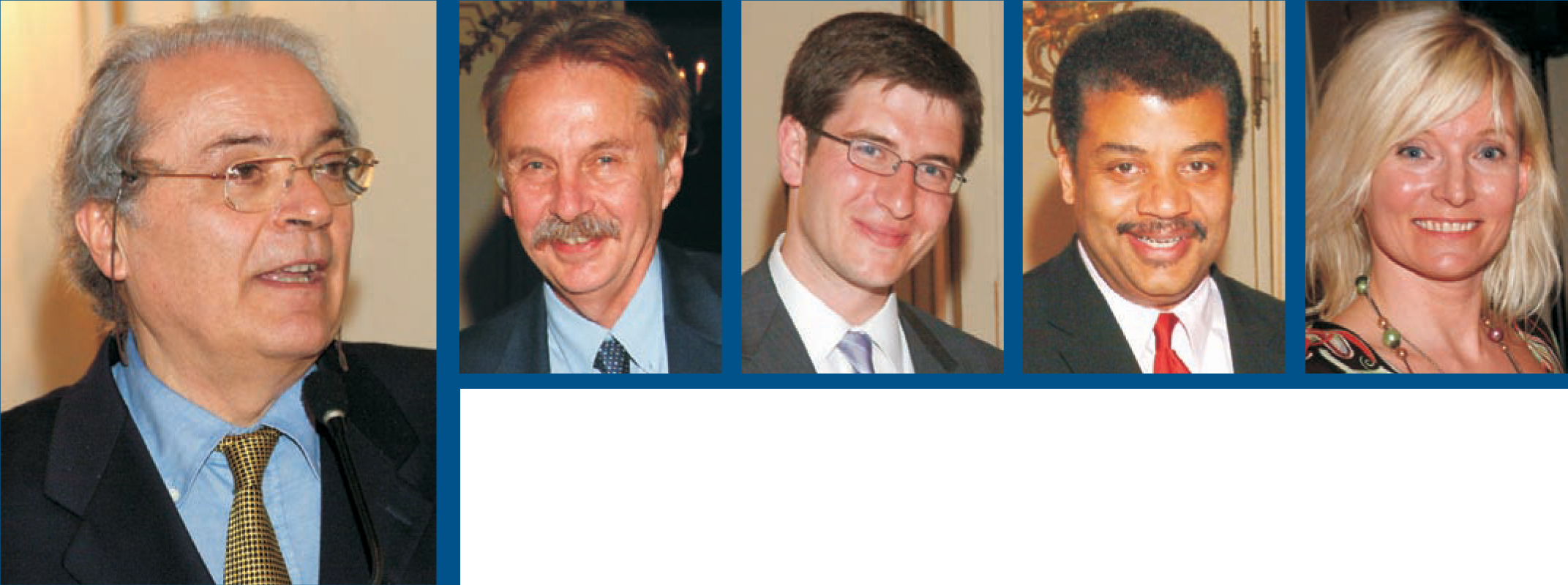The American Institute of Physics: 75 years of service
DOI: 10.1063/1.2218551

AIP executive directors and Governing Board chairs. (L–R) Roland Schmitt (GBC, 1993–98), Marc Brodsky (ED, 1993–present), Mildred Dresselhaus (GBC, 2003–present), H. William Koch (ED, 1966–87), Hans Frauenfelder (GBC, 1986–93), Norman Ramsey (GBC, 1980–86), John Armstrong (GBC, 1998–2003), Kenneth Ford (ED, 1987–93).
(All photos on these pages by Hilary Schwab Photography.)

In May 1931, five scientific societies embracing different sets of disciplines banded together to create the American Institute of Physics. This year, augmented in the interim by five other societies, AIP is celebrating three-quarters of a century of service and achievement.
As we prepared for the celebration, it was somewhat strange to read of the AIP founders’ worries about the inordinate growth and fragmentation of physics. Those early concerns pale in comparison to the scale of similar challenges today—the knowledge explosion we are now witnessing, the globalization of research and development, and the new fields that are emerging even as other fields come together in unexpected ways.
In 1931, excitement stirred the air with an enormous flow of discoveries, from the submicroscopic world of quantum mechanics to the newly envisioned expansion of the universe. Today is no less exciting, with an exhilarating range of physical and conceptual ideas, frameworks, and tools covering all regimes from the tiniest to the grandest. The diverse frontiers offer unprecedented challenges and opportunities both for today’s scientists and for the students who will become tomorrow’s scientists.
Last month, AIP celebrated its diamond anniversary with a symposium at which several leaders in science addressed the frontiers of physics and related fields, and presented some visions for the future. They spoke not only of science but also of people. At AIP’s birth, in the minutes of its first Governing Board meeting, it was envisioned “that one publication be designed and operated in such a way as to reach a wide audience of men working in physics and to give them easily readable news of all kinds relating to physics.” Seventeen years later, Physics Today came into existence as a unifying force for the entire AIP community, men and women alike. Thus, it is fitting for Physics Today to bring together for the worldwide community a set of views on the diverse frontiers, then and now, as well as these pictures from the symposium.

Symposium speakers. (L–R) James Stith (AIP), Marc Brodsky (AIP), Raymond Jeanloz (UC Berkeley), Mildred Dresselhaus (MIT), Spencer Weart (AIP), Evelyn Hu (UCSB), Philip Bucksbaum (Stanford U), Marvin Cohen (UC Berkeley), Lawrence Crum (U Washington), Martin Rees (Cambridge U), Steven Chu (Lawrence Berkeley), Angela Belcher (MIT), S. James Gates (U Maryland), Shirley Malcom (AAAS), Hans Frauenfelder (Los Alamos).

Beginning on page 32, Spencer Weart takes us on a worldwide scientific expedition, looking for trends over the past 75 years, and John Marburger (page 38) walks us through the evolution of science policy over those years.
The scientists and engineers who belong to the 10 AIP member societies will surely produce astonishing insights in coming decades. Those researchers, educators, students, and technologists constitute an increasingly diverse body of people, much more inclusive than the nearly all-male bastion of physics in 1931. Yet there are still enormous challenges; beginning on page 44, Shirley Malcom takes a hard look at the demographics and diversity of our community.
This special issue also presents a few samples of the compelling science that surrounds us today: Marvin Cohen (page 48) offers his perspective on condensed matter theory, Jim Gates (page 54) writes about the state of string theory, and Phil Bucksbaum (page 57) reflects on optical science.
The coming together of societies in 1931 exemplifies the paradox of related yet disparate disciplines needing each other, both for mutual intellectual ferment and for practical reasons of shared efficiencies. That same paradox rings true today. The boundaries between scientific endeavors sometimes isolate researchers even as those boundaries must be breached to address questions that do not divide neatly into traditional disciplines. Today’s challenges include finding ways in which science can help improve human welfare worldwide in such areas as energy, climate change, health care, and arms proliferation, and address the needs of a rapidly growing population with new aspirations.
As we look to the future, grave uncertainties rise to meet us. But one remaining certainty is the important role that physics, in its broadest, most multidisciplinary sense, will play in providing knowledge and technology for many years to come. The many frontiers before us—whether large or small, cosmological or submicroscopic, biological or geophysical, theoretical or practical, involving interactions of light or matter or sound—offer unbounded opportunities for AIP and its diverse community to continually contribute to the advancement and diffusion of knowledge of the science of physics and its applications to human welfare.

Science leaders take time for the camera. Arden Bement (left) is the director of the NSF; Ralph Cicerone is the president of the National Academy of Sciences.


Presidential science adviser John Marburger (left) talking with Norman Ramsey (Harvard U), Katharine Gebbie (NIST), and Joe Eberly (U Rochester).


Award winners. During the celebrations on 3 May, the Tate Medal for International Leadership in Physics, awarded by AIP every two years, was presented to Erio Tosatti (far left) for his “tireless effort in helping scientists from developing countries.” The AIP Science Writing Awards in four categories went to (from left) Jon Palfreman (broadcast media; WNET New York, “Innovation: Light Speed”), Michael Moyer (journalist; Popular Science, “Journey to the 10th Dimension”), Neil deGrasse Tyson (scientist; Natural History Magazine, “In the Beginning”), and Bea Uusma Schyffert (children’s books; Chronicle Books, The Man Who Went to the Far Side of the Moon).

More about the Authors
Marc Brodsky is the executive director and chief executive officer of the American Institute of Physics, headquartered in College Park, Maryland. Mildred Dresselhaus is the chair of AIP’s Governing Board; she is also an institute professor and a professor of physics and of electrical engineering at Massachusetts Institute of Technology in Cambridge, Massachusetts.
Marc H. Brodsky. American Institute of Physics, College Park, Maryland, US .
Mildred S. Dresselhaus. Massachusetts Institute of Technology, Cambridge, Massachusetts, US .
